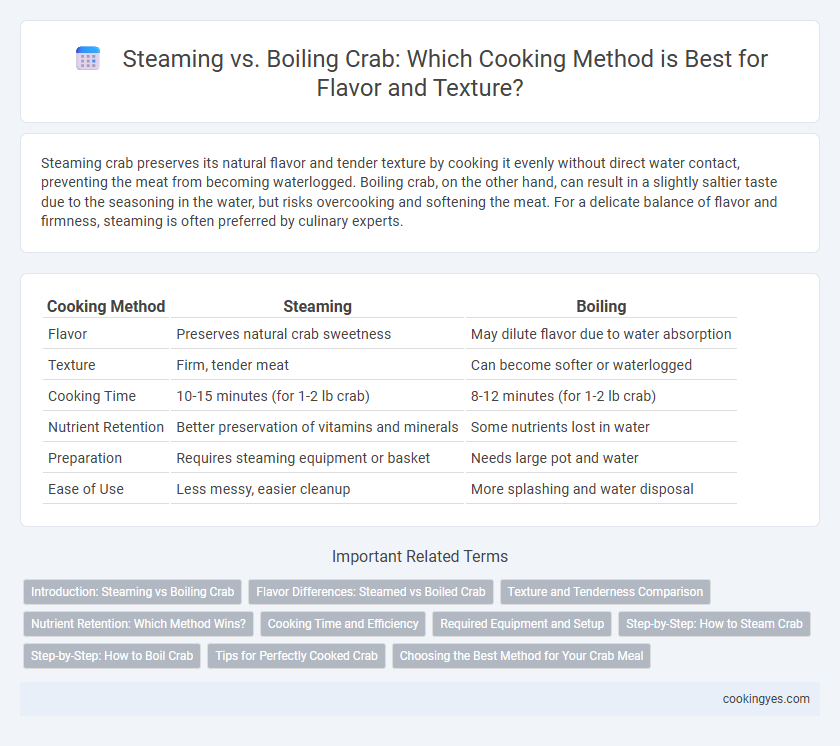Steaming crab preserves its natural flavor and tender texture by cooking it evenly without direct water contact, preventing the meat from becoming waterlogged. Boiling crab, on the other hand, can result in a slightly saltier taste due to the seasoning in the water, but risks overcooking and softening the meat. For a delicate balance of flavor and firmness, steaming is often preferred by culinary experts.
Table of Comparison
| Cooking Method | Steaming | Boiling |
|---|---|---|
| Flavor | Preserves natural crab sweetness | May dilute flavor due to water absorption |
| Texture | Firm, tender meat | Can become softer or waterlogged |
| Cooking Time | 10-15 minutes (for 1-2 lb crab) | 8-12 minutes (for 1-2 lb crab) |
| Nutrient Retention | Better preservation of vitamins and minerals | Some nutrients lost in water |
| Preparation | Requires steaming equipment or basket | Needs large pot and water |
| Ease of Use | Less messy, easier cleanup | More splashing and water disposal |
Introduction: Steaming vs Boiling Crab
Steaming crab preserves its natural sweetness and delicate texture by cooking it gently with steam, while boiling crab submerges it in water, often resulting in slightly diluted flavors. Steaming requires less water and retains more nutrients, making it a healthier option compared to boiling. Both methods effectively cook crab, but steaming is preferred for enhancing the crab's original taste and maintaining its firmness.
Flavor Differences: Steamed vs Boiled Crab
Steaming crab preserves its sweet, natural flavor by cooking the meat gently and preventing the crustacean from submerging in water, resulting in a more delicate texture. Boiling crab can cause some flavor loss as the meat absorbs and leaches into the cooking water, often making it less sweet but infused with seasoning from the broth. Steamed crab typically offers a cleaner, more concentrated taste, ideal for savoring the subtle oceanic notes.
Texture and Tenderness Comparison
Steaming crab preserves the natural sweetness and results in a firmer, more succulent texture due to gentle heat exposure. Boiling crab often leads to a softer, sometimes mushier meat texture as the crab is fully submerged in rapidly boiling water. For optimal tenderness and intact flavor, steaming is generally preferred over boiling in crab preparation.
Nutrient Retention: Which Method Wins?
Steaming crab preserves more nutrients compared to boiling, as it minimizes direct contact with water, reducing the leaching of water-soluble vitamins like B-complex and C. Boiling causes greater nutrient loss due to the crab being submerged in water, which can wash away essential minerals and antioxidants. Therefore, steaming is the preferred cooking method for retaining maximum nutritional value in crab meat.
Cooking Time and Efficiency
Steaming crab typically takes around 15-20 minutes, preserving its natural sweetness and texture while minimizing water contact to prevent flavor loss. Boiling crab requires a similar 10-15 minute cooking time but can sometimes lead to a slightly diluted taste due to direct water immersion. Steaming is generally considered more efficient for maintaining crab's delicate flavor and ideal texture without overcooking.
Required Equipment and Setup
Steaming crab requires a large pot with a steaming rack or basket to keep the crab elevated above boiling water, allowing for gentle, even heat distribution that preserves flavor and texture. Boiling crab demands a pot spacious enough to fully submerge the crab in rapidly boiling water, often necessitating a lid to maintain consistent temperature and reduce cooking time. Both methods benefit from sturdy tongs or gloves for safe handling, but the steaming setup is typically more energy-efficient and less messy than boiling.
Step-by-Step: How to Steam Crab
Place a pot with a steaming rack and one to two inches of water on the stove, bringing it to a boil. Rinse the crab under cold water, then place it on the steaming rack, cover with a tight-fitting lid, and steam for 15-20 minutes until the shell turns bright orange and the meat is opaque. Remove the crab carefully using tongs and let it cool slightly before cracking the shell to enjoy tender, flavorful crab meat.
Step-by-Step: How to Boil Crab
Boiling crab involves filling a large pot with water, adding salt and seasoning like Old Bay or lemon slices, then bringing it to a rolling boil before submerging the live crab. Maintain the boil and cook the crab for 12-15 minutes, depending on size, until the shell turns bright red and the meat is opaque. Remove the crab carefully with tongs, cool slightly, and serve with drawn butter or your preferred dipping sauce for optimal flavor.
Tips for Perfectly Cooked Crab
Steaming crab preserves its natural sweetness and tenderness by cooking it evenly without immersing in water, typically requiring 15-20 minutes per pound over boiling water. Boiling crab involves submerging it in heavily salted, seasoned water, which can infuse additional flavor but may dilute the meat's delicate taste, usually taking 12-15 minutes per pound. To achieve perfectly cooked crab, use fresh or fully thawed crabs, avoid overcrowding the pot, and immediately cool crabs in ice water after cooking to stop the cooking process and maintain optimal texture.
Choosing the Best Method for Your Crab Meal
Steaming crab preserves its natural sweetness and tender texture by cooking it gently with steam instead of submerging in water. Boiling can infuse the crab meat with seasoning but risks overcooking and diluting delicate flavors. For a flavorful, moist crab meal, steaming is often the best method, especially for fresh or premium crabs.
Steaming vs Boiling for cooking crab Infographic

 cookingyes.com
cookingyes.com